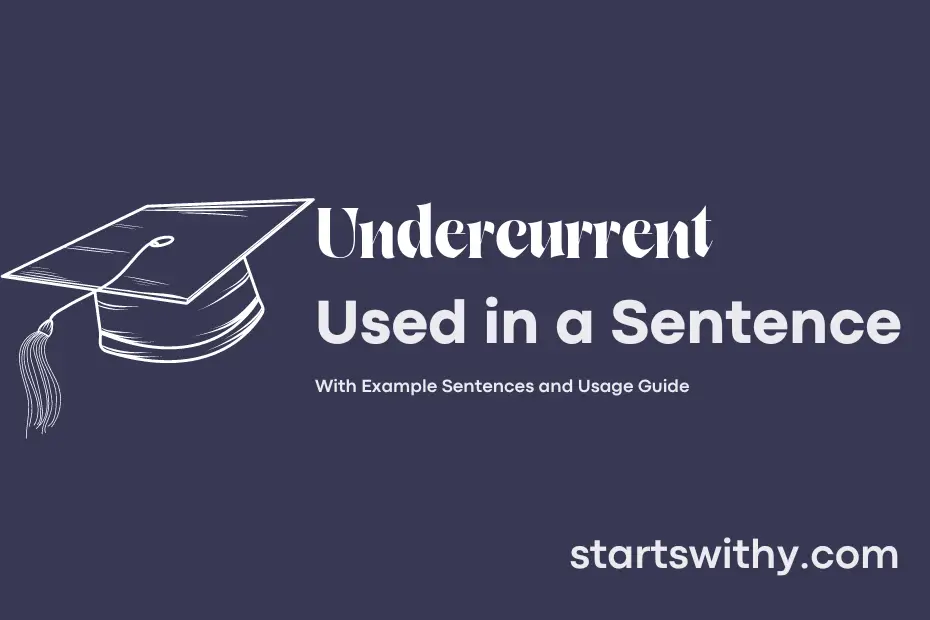Have you ever felt an undercurrent of emotion in a situation, a subtle feeling that runs beneath the surface but is not openly expressed? This hidden force, known as an undercurrent, can significantly influence interactions and decision-making.
An undercurrent can be likened to an unseen river flowing beneath a calm surface, shaping the direction and dynamics of a situation. Recognizing these underlying feelings or tensions can provide valuable insights into the true nature of a scenario, helping us navigate complex social dynamics and communicate effectively.
7 Examples Of Undercurrent Used In a Sentence For Kids
- The undercurrent of the river was very strong.
- Be careful of the undercurrent when swimming in the sea.
- Fish can feel the undercurrent of the water.
- The undercurrent can carry objects downstream.
- Let’s listen to the sound of the undercurrent.
- The undercurrent can make the boat move faster.
- The undercurrent is like a secret river below the surface.
14 Sentences with Undercurrent Examples
- College students in India often experience undercurrents of competition and pressure to excel in academics.
- There is an undercurrent of excitement in the air as the college fest approaches.
- The undercurrent of cultural diversity among college students enriches the campus environment.
- Students should be aware of the political undercurrents on campus and stay informed about current events.
- The relationship between professors and students often has a subtle undercurrent of mutual respect and admiration.
- There is an undercurrent of creativity and innovation among college students working on various projects.
- Social media plays a significant role in creating undercurrents of influence and trends among college students.
- The undercurrent of stress during exam season can be overwhelming for many college students.
- Group dynamics in college projects can sometimes have an undercurrent of power struggles and conflicting personalities.
- The undercurrent of friendship and camaraderie among college roommates can lead to lifelong bonds.
- The campus protests had an undercurrent of dissatisfaction and frustration among the student body.
- The student elections were marked by an undercurrent of rivalry and tension between different political groups.
- College students should be attuned to the social undercurrents that shape opinions and behaviors in their peer group.
- The issue of mental health on campus has an undercurrent of stigma that needs to be addressed through awareness and support systems.
How To Use Undercurrent in Sentences?
To use “Undercurrent” in a sentence, start by identifying the underlying feeling, emotion, or idea that you want to convey. Then, craft a sentence that subtly hints at this hidden aspect, adding depth and complexity to your communication.
For example, consider the sentence: “Although she seemed calm on the surface, there was an undercurrent of tension in her voice.” In this sentence, the word “undercurrent” is used to suggest that there is a hidden feeling of unease or stress beneath the apparent calmness.
Another way to use “Undercurrent” is in a sentence like: “The novel had a dark undercurrent that added a sinister layer to the seemingly ordinary story.” Here, the word “undercurrent” implies that there is a hidden theme or tone in the novel that contrasts with its outward appearance.
When using “Undercurrent” in a sentence, be mindful of the context and tone of your communication. The word is often used to convey subtlety, nuance, and depth, so think about how it can enhance the overall meaning of your sentence.
In summary, undercurrent is a powerful word that can add layers of meaning to your sentences. By incorporating it thoughtfully, you can create more dynamic and engaging communication that resonates with your audience.
Conclusion
In literature, sentences with an undercurrent often convey hidden meanings or emotions beneath the surface. These sentences can add depth and complexity to a text, engaging readers in a more nuanced interpretation of the content. By incorporating subtle nuances and subtext, writers can create a sense of intrigue and intrigue that keeps the audience captivated.
Moreover, sentences with an undercurrent can contribute to the overall tone and atmosphere of a piece, enhancing the reader’s experience and providing added layers of meaning. Whether subtly hinting at underlying tensions or conveying a sense of mystery, these sentences can evoke powerful emotions and provoke thought, making them a valuable tool in effective communication and storytelling.



